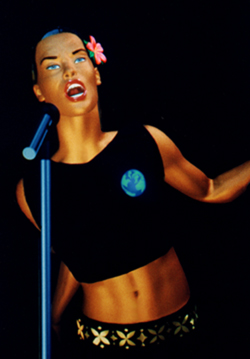Science Fiction
Dictionary
A B C D E F G H I J K L M N O P Q R S T U V W X Y Z
James Cameron's Avatar Synthespians

Synthespians are "synthetic thespians", or artificial actors. James Cameron, director of Avatar, has been quoted as saying that the same technology that animated the Na'vis from Pandora could also be used to bring beloved actors back to the screen. But would it be ethical? And would movie-goers want to see it?
Cameron's process is very precise - even the pores of an actor's skin are imaged in the facial screening process. But the actor herself or himself, the psychological makeup and choices, cannot be scanned (yet).
(Sigourney Weaver's avatar)
“How about another Dirty Harry movie where Clint looks the way he looked in 1975?” Cameron suggests. “Or a James Bond movie where Sean Connery looks the way he did in Doctor No? How cool would that be?”“If Tom Cruise left instructions for his estate that it was okay to use his likeness in Mission Impossible movies for the next 500 years, I would say that would be fine,” says Cameron. Less fine, at least to Cameron, is bringing long dead stars back to life. “You could put Marilyn Monroe and Humphrey Bogart in a movie together, but it wouldn’t be them. You’d have to have somebody play them. And that’s where I think you cross an ethical boundary…”
The word "synthespian" was coined by Jeff Kleiser. Kleiser and Diana Walczak created the first digital actor for their 1988 short film Nestor Sextone for President.

A year later, the pair created a short film Don't Touch Me, featuring a singing synthespian named Dozo.

Intrigued by the potential of motion capture to link natural human motion to our synthetic characters, we created Don't Touch Me, a music video piece that premiered at SIGGRAPH 1990 in which singer/songwriter Perla Batalla was optically motion captured (by Motion Analysis in Santa Rosa, CA) to drive a singing synthespian called Dozo. By this time, we had suitable flexing software for simple joints like elbows and knees, but the multi-axis requirements for the shoulder joint meant a solution was still several months of development away.Facial animation was again created by linking digitized sculptures of various facial expressions and this technique yielded superior results to any of the software solutions of the time that sought to model the musculature of the face. Software solutions would require many years of development before they would overcome the quality and believability of the sculpture-based technique, which allowed for the preservation of facial volume and the illusion of the preservation of facial muscle integrity during motion.
(From Synthespianism by Jeff Kleiser)
SF writer William Gibson included the idea of synthespians in his 1996 novel Idoru:
"What did Blackwell mean, last night, about Rez wanting to marry a Japanese girl who isn't real?" "Idoru," Yamazaki said... "'Idol-singer.' She is Rei Toei. She is a personality-construct, a congeries of software agents, the creation of information-designers. She is akin to what I believe they call a 'synthespian,' in Hollywood."
(Read more about Gibson's synthespian)
Update 21-Jan-2010: Jeff Kleiser happened to see this article, and wrote in with exactly what I was looking for - a video showing Nestor Sextone for President. This is a compilation video; see the portion beginning at 2:00:
"Max Headroom was written and directed by Rocky Morton and Annabel Jankel (now of MJZ) and they used Matt Frewer in makeup to represent a CG character. We were poking fun at them in Nestor Sextone for President: Nestor is running for president of the synthetic actors guild, and promising that humans in makeup will no longer take work away from synthetic actors." - Jeff Kleiser
End update.
From Popwatch.
Scroll down for more stories in the same category. (Story submitted 1/19/2010)
Follow this kind of news @Technovelgy.| Email | RSS | Blog It | Stumble | del.icio.us | Digg | Reddit |
Would
you like to contribute a story tip?
It's easy:
Get the URL of the story, and the related sf author, and add
it here.
Comment/Join discussion ( 11 )
Related News Stories - (" Culture ")
Is It Time To Forbid Human Driving?
'Heavy penalties... were to be applied to any one found driving manually-controlled machines.' - Bernard Brown, 1934.
Indonesian Clans Battle
'The observation vehicle was of that peculiar variety used in conveying a large number of people across rough terrain.' - Jack Vance (1952)
Liuzhi Process Now In Use In China
'He was in a high-ceilinged windowless cell with walls of glittering white porcelain.' - George Orwell, 1984.
Animated Tumblebugs On Astounding Cover!
'Gaines and Harvey mounted tumblebugs, and kept abreast of the Cadet Captain...'
Technovelgy (that's tech-novel-gee!) is devoted to the creative science inventions and ideas of sf authors. Look for the Invention Category that interests you, the Glossary, the Invention Timeline, or see what's New.
Science Fiction
Timeline
1600-1899
1900-1939
1940's 1950's
1960's 1970's
1980's 1990's
2000's 2010's
Current News
The Zapata Air Scooter Would Be Great In A Science Fiction Story
'Betty's slapdash style.'
Thermostabilized Wet Meat Product (NASA Prototype)
There are no orbiting Michelin stars. Yet.
Could Crystal Batteries Generate Power For Centuries?
'Power could be compressed thus into an inch-square cube of what looked like blue-white ice'
India Ponders Always-On Smartphone Location Tracking
'It is necessary... for your own protection.'
Amazon Will Send You Heinlein's Knockdown Cabin
'It's so light that you can set it up in five minutes by yourself...'
Is It Time To Forbid Human Driving?
'Heavy penalties... were to be applied to any one found driving manually-controlled machines.'
Replace The Smartphone With A Connected Edge Node For AI Inference
'Buy a Little Dingbat... electropen, wrist watch, pocketphone, pocket radio, billfold ... all in one.'
Artificial Skin For Robots Is Coming Right Along
'... an elastic, tinted material that had all the feel and appearance of human flesh and epidermis.'
Robot Guard Dog On Duty
I might also be thinking of K-9 from Doctor Who.
Wearable Artificial Fabric Muscles
'It is remarkable that the long leverages of their machines are in most cases actuated by a sort of sham musculature...'
BrainBridge Concept Transplant Of Human Head Proposed
'Briquet’s head seemed to think that to find and attach a new body to her head was as easy as to fit and sew a new dress.'
Google's Nano Banana Pro Presents Handwritten Math Solutions
'...copy was turned out in a charming and entirely feminine handwriting.'
Edible Meat-Like Fungus Like Barbara Hambly's Slunch?
'It was almost unheard of for slunch to spread that fast...'
Sunday Robotics 'Memo' Bot Has Unique Training Glove
'He then started hand movements of definite pattern...'
Woman Marries Computer, Vonnegut's Dream Comes True
'Men are made of protoplasm... Lasts forever.'
Natural Gait With Prosthetic Connected To Nervous System
'The leg was to function, in a way, as a servo-mechanism operated by Larry’s brain...'
